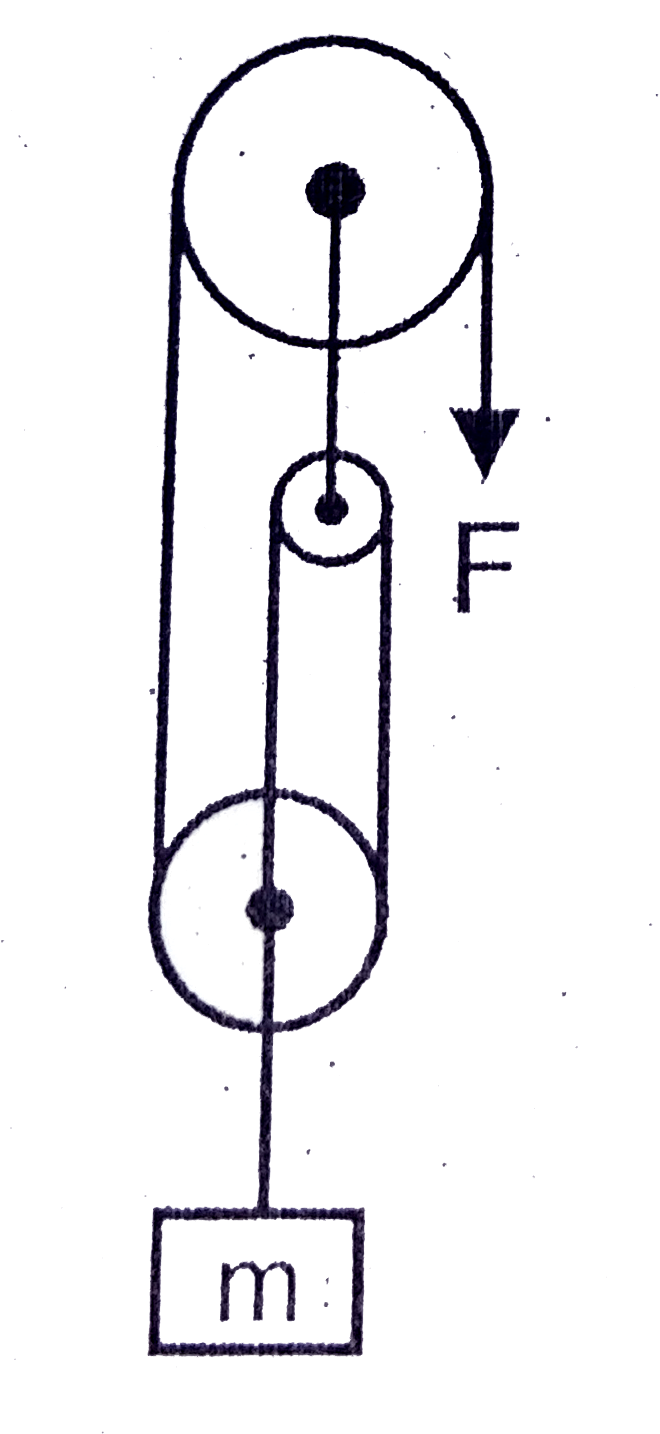Human heart is pumping blood with constant velocity v m s−1 at the rate of M kg s−1. The force required for this is (in N)
M
Mv
Mv
vdMdt
The correct Answer is:B
To find the force required for the human heart to pump blood at a constant velocity, we can use the principles of physics, particularly Newton's second law of motion. Here’s a step-by-step solution:
Step 1: Understand the Given Information
- The velocity of blood being pumped is v m/s.
- The rate of blood flow (mass flow rate) is M kg/s.
Step 2: Recall Newton's Second Law of Motion
Newton's second law states that the force F required to change the momentum of an object is equal to the rate of change of momentum. Mathematically, this is expressed as:
F=dpdt
where p is the momentum.
Step 3: Define Momentum
The momentum p of an object is defined as the product of its mass m and its velocity v:
p=mv
Step 4: Calculate the Rate of Change of Momentum
Since the mass flow rate is given as M kg/s, we can express the rate of change of momentum as:
dpdt=d(mv)dt
Given that the velocity v is constant, we can simplify this to:
dpdt=vdmdt
Here, dmdt is the mass flow rate, which is equal to M kg/s.
Step 5: Substitute the Values
Substituting dmdt=M into the equation gives:
dpdt=v⋅M
Step 6: Write the Force Equation
Thus, the force F required to pump the blood is:
F=v⋅M
Final Answer
The force required for the heart to pump blood is:
F=Mv N
---
- The velocity of blood being pumped is v m/s.
- The rate of blood flow (mass flow rate) is M kg/s.
Newton's second law states that the force F required to change the momentum of an object is equal to the rate of change of momentum. Mathematically, this is expressed as:
F=dpdt
where p is the momentum.
The momentum p of an object is defined as the product of its mass m and its velocity v:
p=mv
Since the mass flow rate is given as M kg/s, we can express the rate of change of momentum as:
dpdt=d(mv)dt
Given that the velocity v is constant, we can simplify this to:
dpdt=vdmdt
Here, dmdt is the mass flow rate, which is equal to M kg/s.
Substituting dmdt=M into the equation gives:
dpdt=v⋅M
Thus, the force F required to pump the blood is:
F=v⋅M
The force required for the heart to pump blood is:
F=Mv N
Topper's Solved these Questions
- FORCE BOOK - TARGET PUBLICATIONCHAPTER - FORCE EXERCISE - Critical Thinking (4.1 Types of force)
1 Video
- FORCE BOOK - TARGET PUBLICATIONCHAPTER - FORCE EXERCISE - Critical Thinking (4.2 General idea of gravitational, electromagnetic and nuclear force electromagnetic and nuclear force from daily life experiences)
1 Video
- FORCE BOOK - TARGET PUBLICATIONCHAPTER - FORCE EXERCISE - Classical Thinking (Miscellaneous)
3 Videos
- ELECTRONS AND PHOTONSBOOK - TARGET PUBLICATIONCHAPTER - ELECTRONS AND PHOTONSEXERCISE - Evaluation Test
19 Videos
- FRICTION IS SOLIDS AND LIQUIDS BOOK - TARGET PUBLICATIONCHAPTER - FRICTION IS SOLIDS AND LIQUIDS EXERCISE - MCQ (EVALUATION TEST)
21 Videos
Similar Questions
An open carriage in a goods train is moving with a uniform velocity of 10 m/s. If the rain adds water with zero velocity at the rate of 5 kg/s, then the additional force required by the engine to maintain the same velocity of the train is
View SolutionAn object of mass 10 kg is moving with an initial velocity of 10ms−1. A constant force acts for 4 s on the object giving it a speed of 2 m s−1 in the opposite direction. Find the acceleration and force.
View Solution
Knowledge Check
In the block moves up with constant velocity v m//s. Find F
 AF=mg2BF=2mg3CF=mg3DF=m3
AF=mg2BF=2mg3CF=mg3DF=m3A cart is moving with a velocity 20m/s. Sand is being dropped into the cart at the rate of 50 kg/min. The force required to move the cart with constant velocity will be :-
A50 NB30.33NC26.45ND16.66NA train is moving with velocity 20m/sec . on this dust is falling at the rate of 50 kg / minute . The extra force required to move this train with constant velocity will be
A16.66 NB1000 NC166.6 ND1200 N
An object of mass 10 kg is moving with an initial velocity of 10ms−1. A constant force acts for 4 s on the object giving it a speed of 2 m s−1 in the opposite direction. Find the acceleration and force.
View SolutionA cricket ball of mass 0.5 kg strikes a circket bat normally with a velocity of 20 m s−1 and rebounds with a velocity of 10 m s−1. The impulse of the force exerted by the ball on the bat is
View SolutionIf the force on a rocket moving with a velocity of 300m/s is 345 N, then the rate of combustion of the fuel is
View SolutionAn external force 6N is applied on a sphere of radius R = 10 cm of mass 1 kg and the sphere moves in a liquid with a constant velocity 5 m/s making 530 with the horizontal.The coefficient of viscosity of the liquid is 20/(6π), in S.I units. (Take g=10m/s2)

View SolutionAn object of mass 5 kg is sliding on a smooth frictionless horizontal surface with a constant velocity of 10 m/s. the force required to keep the object moving with the same velocity is
View Solution
